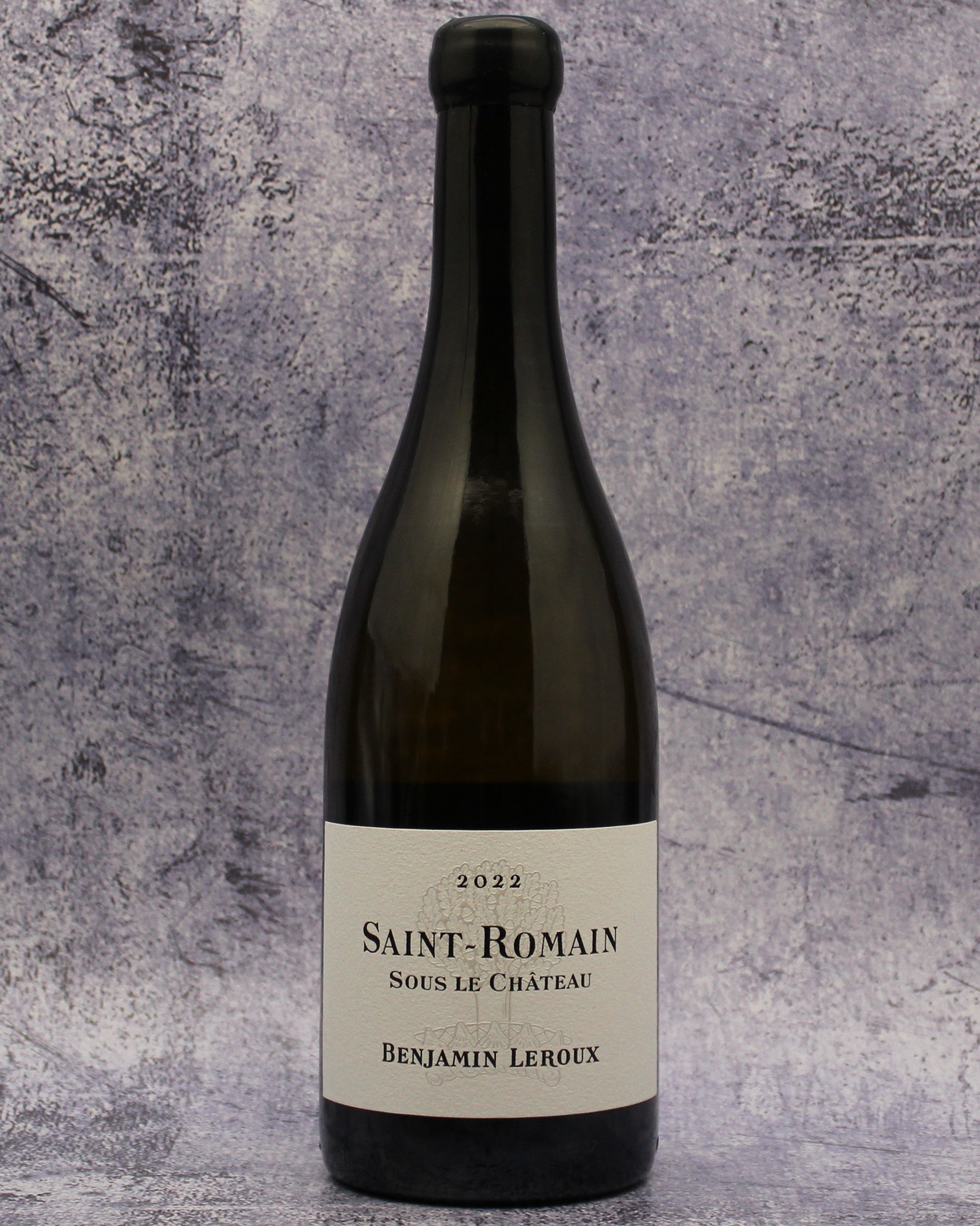Description
From: Burgundy, France
Varietal: Chardonnay
This wine. Notes: Leroux’s Saint-Romain hails from 0.5 hectares (split into two parcels) in the lieu-dit of Sous le Château. Organically farmed, the two parcels are 60 and 20 years old. The stony, rugged soils are typical of Saint-Romain’s terroir, yet the site is well protected from the northern winds, and the plethora of stones on the soil’s surface radiate heat. Vinification was half in foudres and half in 300-litre barrels.
Taste & Critical Acclaim: This charming wine is full of verve and vivid fruits. When it is opened, a noticeable vein of minerality is present, and juicy granny apple, lush stone fruits, confit citrus (lemon and grapefruit), and taut acidity frame it. These flavors continue to open and evolve with air, and as they do, those stone fruit flavors morph into more exotic ones like mango and guava, all while retaining their taut, mineral spine and chalky finish. - E. Lyman, Champion Wine Cellars, November 2024.
The 2022 Saint Romain Sous Le Château, which came from tank on the lees, has a lively green apple and grapefruit-scented bouquet. The palate is medium-bodied with a waxy texture, tropical hints of guava and dried pineapple with a dash of lemongrass towards the finish. Fine. 89-91 Neal Martin, Vinous (2023).
Benjamin was able to keep the lees after racking as they were so pure and continue to nourish the wine. Very pale in colour. There is plenty of energy here, lemon infused up front, just the right flesh behind, with a long, agile finish. **** 90 Jasper Morris, Inside Burgundy (2023).
Pairing: This vivacious Saint-Romain will pair wonderfully with a myriad of dishes. Seafood and poultry pairings top the list, although vegetarian dishes that balance crunchy, sweet, and fatty elements, like Alexa Weibel’s Crispy Rice Salad with Halloumi and Ginger-Lime Vinaigrette (check it out below), would work beautifully. Some specific pairing ideas include serving this wine with shrimp and scallop dumplings, shrimp dumplings with a saffron shallot sauce, crab cakes or crab Rillette served with an endive salad, pan-roasted fish fillets with herb butter (check out the recipe below), pan-roasted chicken in cream sauce, and the always classic Poulet roti tout simple (simple roast chicken).
Crispy Rice Salad With Halloumi and Ginger-Lime Vinaigrette
By Alexa Weibel
Pan-Roasted Fish Fillets With Herb Butter
Recipe from Mark Usewicz
Adapted by Julia Moskin
Domaine Profile by Vicki Denig and Becky Wasserman & Co, 2021.
About. At a Glance.
Location: Beaune, Côte de Beaune, Burgundy
History: Ben was born in 1975 in Beaune, not to a vigneron family, yet decided in his teens that wine was what he wanted to do. After his enology studies, he worked at Cos d'Estournel in Bordeaux, Domaine Drouhin in Oregon, Louis Jadot in Beaune, and Comte Armand in Pommard, where he was named technical director and manager at the age of 24. In 2007, he founded his own domaine and négoce.
Size: Domaine: 8 ha (19.77 ac); Grape purchases: 20 ha (49.42 ac)
Varieties: Pinot Noir, Chardonnay, Aligoté
Farming: Domaine: certified organic, practicing biodynamic; Grape Purchases: Sustainable, organic, and biodynamic
White Winemaking: Uncrushed whole-cluster pressing; ambient yeast fermentation in tank, barrels or foudres; ageing for 12 to 22 months; fining is not systematic; filtration is avoided; bottled since 2019 with Diam corks and 50 to 70ppm total sulfur.
Red Winemaking: Up to 30% whole cluster depending on vintage and cuvée; ambient yeast fermentation; pumpovers in the beginning, punch downs towards the end, 3 to 5 on average; post fermentation maceration; aged in foudres or barrels, maximum 30% new oak; rarely fined or filtered; natural cork closures; 40 to 50ppm sulfur at bottling.
One of the wonderful aspects of Domaine du Comte Armand, is the family’s habit since 1985 of placing their trust in surprisingly youthful talent. Their instincts have been remarkable. Between Pascal Marchand and Paul Zinetti was Benjamin Leroux, who was handed the reins of the domaine in 1999, at the age of 24.
Ben stayed at Comte Armand for fifteen vintages and started his own side project in 2007. Though there are no family vineyards, he now vinifies approximately 30 hectares, 8 of which are domaine holdings that are farmed organically and biodynamically.
His range of appellations is astounding. It spans the Côte from Chassagne-Montrachet to Gevrey-Chambertin, and includes all levels in Burgundy’s hierarchy. Particular favorites of ours are his collection of premier crus, not only because many of them are the most prized, but sometimes precisely because of the opposite. Take Blagny. Right? Yet, with its high altitude and white marl soils, it produces reds and whites with such rebellious minerality and freshness they regularly steal the show.
Blagny is a good metaphor for Ben. Though he has become one of the most respected classical winemakers of his generation, his underlying unconformity, wit, and humour are why he is also among everyone’s most loved.

